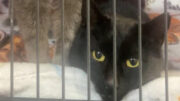What may look like a tiny hummingbird feeding on residents’ flowers may in fact be a moth. These moths are commonly called hummingbird, sphinx or hawk moths. Their scientific name is sphingidae and they belong to the superfamily sphingoidea, according to Butterflies and Moths of North America.
The website, www.butterfliesandmoths.org, said most sphingidae are medium to large moths with heavy bodies. The wingspread can reach 5 inches or more in some species, the site added.
“The sphingidae are strong and fast fliers with a rapid wingbeat,” according to the post on www.butterfliesandmoths.org.
An article by Steve Buchman of The Bee Works posted on the United States Department of Agriculture Forest Services’ website, said that the sphinx moths are “fast flyers and often highly aerobatic. Many species can hover in place. Some can briefly fly backwards or dart away.”
Butterflies and Moths of North America said that most species in the group are active at dusk and “feed much like hummingbirds, hovering in front of a flower and sipping nectar through the extended proboscis.”
“Hawk moths are important pollinators of many different plant species …,” according to a post on the Encyclopedia of Life’s website, eol.org.
“Hawk moths pollinate plants that have flowers with the following traits: nocturnal flower opening, white or pale coloration, sweet fragrance, horizontal to pendant posture, abundant sucrose-rich nectar and a long nectar tube,” the site said.
According to the site eol.org, some hawk moths have been documented with tongues up to 14 inches long. The site was quick to note that “the average North American hawk moth tongue is 2 1/3 inches long with the average nectar tube of flowers pollinated by North American hawk moths just over 2 inches long.”
The site said sphinx moths often fly during twilight or dawn, although some species fly during broad daylight.
Butterflies and Moths of North America went on to mention that the larval stage of most sphinx moths is called a “hornworm” because the caterpillar’s posterior end has a harmless hook or hornlike appendage protruding upward.
“Unfortunately, the caterpillar of some species can be very destructive to agricultural crops and ornamental plantings,” the website added.
Check out the checklist
According to www.butterfliesandmoths.org‘s regional checklist, Venango County is home to six kinds of sphinx or hawk moths.
They are the pawpaw sphinx (dolba hyloeus ), the ash sphinx (manduca jasminearum), the elm sphinx (ceratomia amyntor), snowberry clearwing (hemaris diffinis), hummingbird clearwing (hemaris thysbe) and pandorus sphinx (eumorpha pandorus).
The clearwing moths are somewhat unique in appearance in that they have wings that are transparent almost like a dragonfly’s wings.
However, it can be a little confusing in telling the hummingbird clearwing apart from the snowberry clearwing.
The snowberry clearwing has a black band that crosses the eye and travels down the lateral side of the thorax and has black legs, according to butterfliesandmoths.org.
The hummingbird clearwing lacks of any banding on the lateral side of the thorax and always has yellowish or pale colored legs, according to the site.
Photos for comparing and contrasting the various species can be found in the image gallery at www.butterfliesandmoths.org.
While the regional checklist on Butterflies and Moths of North America’s website is most helpful in narrowing down the search for a particular moth, people may also sign up for an account and submit a sighting. Once one has submitted a photograph and some information about a particular butterfly or moth, an expert will review the submission and email a positive identification to the submitter.
This can be beneficial because sometimes the checklists may not include all the species found in the county or there may have just not been a sighting for that species recorded yet.
Meanwhile, more gladiolus have bloomed (this time in the sunlight) and a young frog or froglet was spotted.
A meadowhawk dragonfly (red) and a bluet damselfly (blue)
A black-eyed Susan
A Walk in the Woods contains photos from newsroom staffer Anna Applegate’s daily jaunts around her neck of the woods. Tagging along on the treks are dogs Buford, Sherman and Sadie, and goats Kyle and Kennedy. Applegate manages the Good Times and can be emailed at bigdogs.thederrick@gmail.com














































